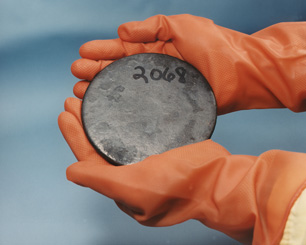Uranium
| EPA Maximum Contaminant Level Goal (MCLG) |
zero |

Refined uranium.
Uranium is a naturally-occurring element found at low levels in virtually all rocks, soil, and water. When refined, it's used for ships, submarines and nuclear weapons. It's also used to fuel nuclear power plants.
Uranium arrives in drinking water most commonly through natural sources.
Health Effects of Uranium
According to the EPA, 99% of uranium ingested on a daily basis is removed rapidly, with the rest being filtered out by the kidneys within a few days.
Excessive amounts can lead to further health effects:
Intakes of uranium exceeding EPA standards can lead to increased cancer risk, liver damage, or both. Long term chronic intakes of uranium isotopes in food, water, or air can lead to internal irradiation and/or chemical toxicity.
Water Treatment for Uranium
Uranium can be treated with reverse osmosis (99% removal), anion exchange, activated alumina adsorption, electrodialysis, and enhanced coagulation/filtration.
Source: EPA, Fundamentals of Radium and Uranium Removal from Drinking Water Supplies by Dennis Clifford, WHO, Photo: WikiMedia, author: US Government
Site Index
Filtration Systems
- Aeration for Iron & Sulfide
- Backwashing Filters
(whole house & well units)
- Chlorine & Chemical Injectors
- Countertop Water Filters
- Garden Hose Filters
- Reverse Osmosis, Residential
- Reverse Osmosis, Commercial
- Shower Filters
- Specialty Filters
- Ultraviolet Systems
- Undersink Filters
- Water Softeners
- Whole House Filters
Cartridges
Parts
- Replacement Parts
- Faucets
- Filter Media
- Fittings
- Housings
- O-rings
- Pumps
- Pura UV
- R.O. Parts
- R.O. Tanks
- R.O. Booster Pump
- VIQUA UV